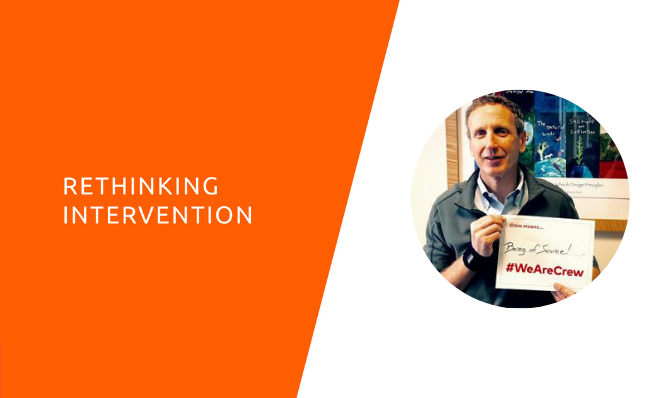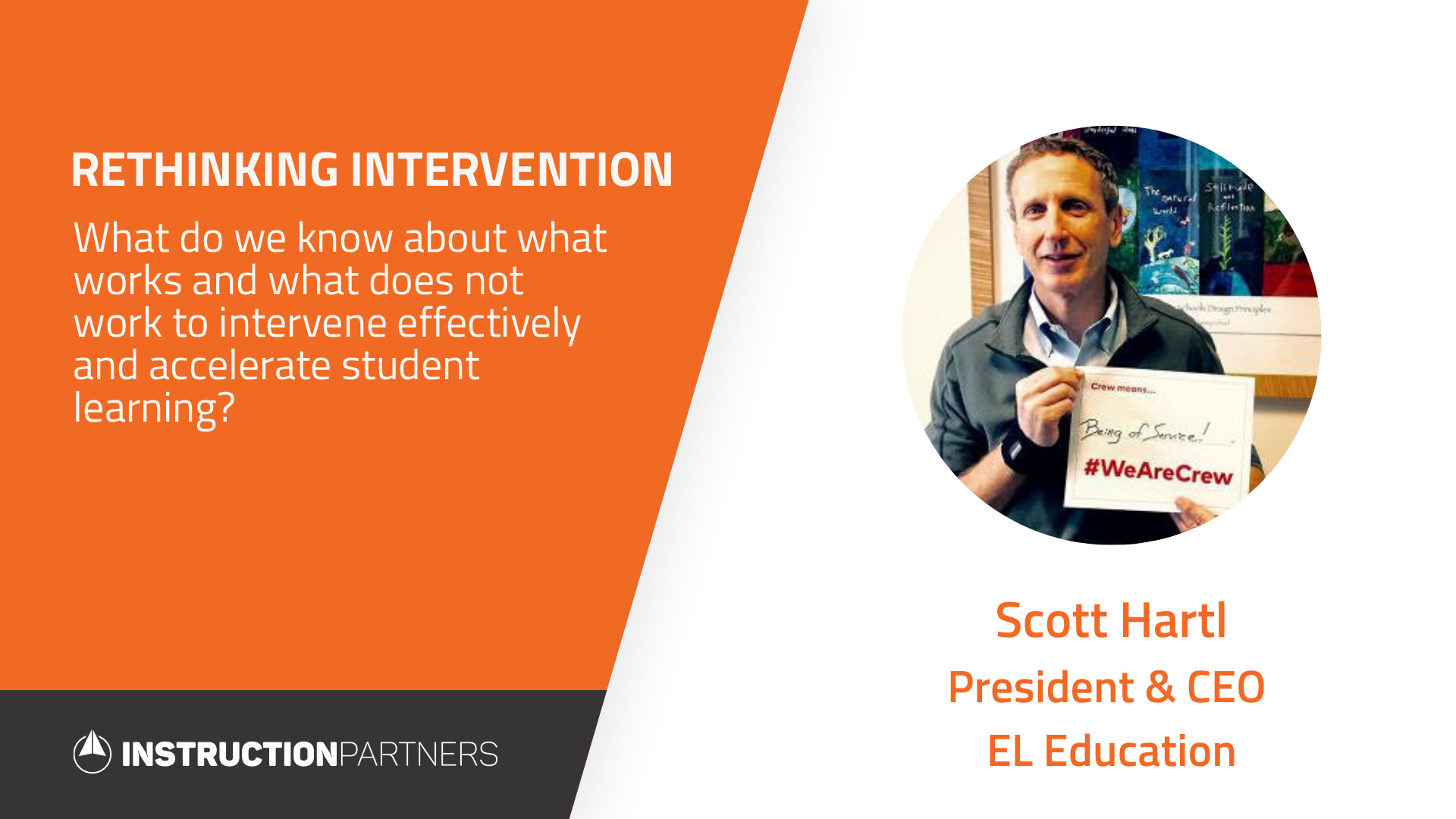
Scott Hartl, EL Education
Scott Hartl, President & CEO of EL Education, spoke to Emily Freitag about the task of accelerating student learning in the aftermath of COVID-19. Scott is a founding member of EL Education, and was named President and CEO in 2009. He has been nationally recognized as a social innovator and entrepreneur, is a Pahara-Aspen Education Fellow, Ashoka Fellow, a Governor’s Appointee to the Massachusetts Creativity Commission, and a member of multiple national advisory groups.
Watch the full conversation or read the abridged Q&A below.

EF: Can you tell us a little bit about yourself as a student and moments that shaped how you think about this work?
SH: It has taken me a lot of years to think about how my own experiences as a student really shaped my professional beliefs. I come from a family that was incredibly successful academically, and I was not always as successful. My mother had two PHDs and raised us as a single mom. She was a teacher and was a very wise teacher. But this was before there was a lot of language around learning disabilities, and clearly, I had some form of what imprecisely is called dyslexia.
When I got a job for EL education, the then-president of EL Education said to me something that has stuck with me and explained my K-12 career. She pulled me aside over a cup of coffee one day and said: “Scott, it’s not that you’re not smart, but you’ve got holes” So, she had picked up on my self-dialogue. And I thought back and realized, that’s right. Because, for me, as I think is true for many, many kids in this country, skill development and knowledge building is not linear or sequential. Very often in K-12, we ask kids to build skill and knowledge at the right time over a body of scope and sequence, and kids like me, who for a number of reasons missed the internalization of that skill or knowledge base when I was supposed to get it, are not afforded a lot of time or opportunity to catch up.
In the hands of good EL education teachers, there is this continuous cycle of engaging kids in work with a purpose that provides the opportunity in ongoing ways to fill in and patch up those holes. We all have “holes” to some degree or another, and in the context of work that is purposeful, engaging, and challenging—that’s when we see kids make extremely impressive gains. So that’s the frame of where I’m coming from, which my own personal experience has informed.
EF: Let’s think about what we know doesn’t work. What have you tried as an educator, or what do you see other educators try, that you have evidence does not work?
SH: EL Education is now coming up on 27 years. We were formed because of a belief that what doesn’t work is worksheet-driven, purely test-focused, nonintegrated approaches to learning. We have explored and been in an antithetical relationship to what we see as a dominant paradigm in American education. So, we consider: How can we build things like integrating character and socio-emotional mindset with academic development, so that the content and standards-alignment is not seen as somehow challenging to working on socio-emotional mindsets and relationships, but rather that the pedagogical approach unifies those things? Our belief is unless you do that, we are not going to close equity gaps, particularly. Who is it that needs a safe space to find academic courage to challenge themselves and fill in their holes to accelerate learning? It’s kids who have not been successful. We need to create the space where we find the pedagogical inroads to tap their strengths and be engaging because of the fundamental intrinsic value of deep, across-disciplines worthy work that draws kids in because of both the challenge and the social value of it.
EL Education has, for the last 15 years, has been guarding against over-focusing on the “big project” and in fact caring more about the quality of daily instruction and the cognitive demand and the engagement on a daily-level. What we know after fifteen years of being a leader in project-based education is that it can lead to tremendous spottiness across time and classrooms, even in very high-functioning schools. We’ve learned that it’s really hard for teachers to develop their own curriculum day-in, day-out, and have consistency in quality. It’s really hard for the form of a project to lead to consistently high-quality daily instruction for all kids. So, what we started doing 10 years ago, was getting into curriculum. And it’s almost funny that EL Education is now a leader in curriculum because we spent the first fifteen years believing that teachers should create all of their own curriculum.
What we have tried to balance, because we believe it doesn’t work, is either extreme—the extreme of disconnected, worksheet-driven education which is not differentiated for different kids, and the extreme of the big project—the fully teacher-created, ongoing, overtime, always-new approach. We’ve tried to find a middle ground to answer: What does it look like to be deeply respectful of teacher craft and practice but have a strong starting place that builds to substantive, big pieces of work? We plan backward over cycles of 8 week time so that the daily instruction builds to the high-quality big work in ways that deliver both meaning and purpose and relevance, and high-quality daily instruction, that integrates a variety of elements of kids learning and development that need to come together.
So, we intentionally weave the academic choices around content with the right pedagogical choices, with the right attention to relationship-building, with the right attention to differentiation. That’s what we have found works.
EF: What do you think educators should prepare for as they think about reentry to schools and recovery from learning loss?
SH: Budgets are likely going to be deeply challenged, so we’re going to need to accelerate learning with less money, with compromised access to whole classes, and with more kids returning processing their own trauma in a number of ways. If that’s the reality educators will be facing in some mix, what does that mean?
I actually don’t think it means a brand-new answer that we’ve never thought of. I do think that it shines a very bright light for people like me to have the courage of conviction, to say something that I might have thought for a decade but with this crisis, I am motivated to be clearer about. And that is this: More kids in this country simply must be given the opportunity to have the core approach to school be an integrated approach that brings worthy work together with sophisticated, student-centered pedagogy in environments across the digital and physical classroom that build community and relationships and provide both a challenging core of work and really good differentiated, individual support. Period. That’s been true for a decade, but it has felt like, with some of the political frame, it was hard to be bold and say that that’s what was needed. Especially because it’s so hard to get to. But at this point, I will say we will not close equity gaps, we will not meet kids across the range of how they are reentering school and bring them back to a path to close gaps, unless our core approach is one that is integrating all of those bodies of knowledge of what good education is. And unless that is done as part of the core approach, I am afraid that the demands of time and money, which are going to be brutal over the next years, will further fracture the approach. Unless your core approach to learning reflects that integrated approach, I am worried that fewer kids rather than more kids will have access to what I’m talking about.
EF: So, I’m hearing more of what we already know works, not a new approach, and integration is more important, not less, given this crisis.
SH: That’s right. And the new challenge is that for everything that we are supporting classroom educators to do, we have to support across the boundaries of the physical classroom and the virtual classroom. That gets to be deeply intimidating.
But I find focus in thinking that this needs to be the core approach to learning. And it’s something that we know how to do. EL Education certainly is one, but many organizations have strong support for this integrated approach to education. And it’s not that everywhere needs to choose one of those models, but everywhere needs to be providing students with that integrated approach to the core-instructional idea of what school is. That’s where I start to get grounded.
EF: I think that speaks to the heart of why a lot of educators got into this work— they are fueled by the integration of disciplines. So now I’m thinking about: How do we recenter on what that looks like?


